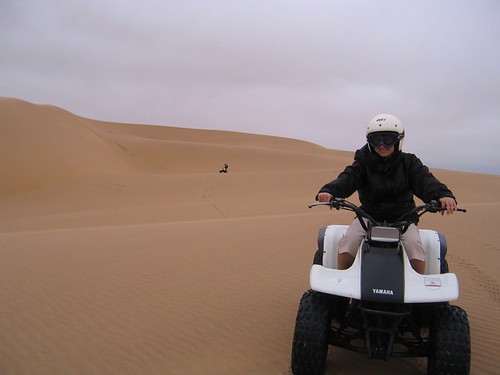
During my recent travels to Namibia, I went on a Historical Dune Tour with Fanie Du Preez, who owns Kuiseb Delta Adventures. As many of you know I am fairly well traveled, but I can honestly say that going with Fanie was one of the most incredible experiences I have ever had. Fanie is passionate about the delta and did a great job showing us everything. I had never been on a quad bike before, and Fanie was very patient and helpful in instructing me (at one point though he did mention that I was doing better than Angelina Jolie!). I highly highly recommend a trip to Namibia, and in particular going with Fanie to see the wonders of the Kuiseb Delta. His website is www.kuisebonline.com.
The reason why I am writing about my dune tour on my food blog is because Fanie showed us, among many other amazing things, two plants that are native to the Kuiseb Delta and I thought it would be interesting to share what I learned. The below information is supplied courtesy of Fanie. The first plant I will talk about is called the !nara (said with a clicking noise at the beginning) and the second, is the sirub.
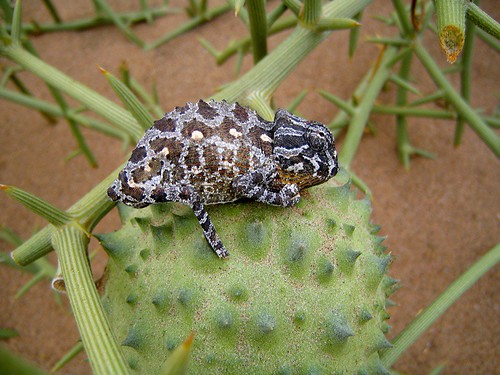
(A !nara fruit with a baby chameleon sitting on top.) See photo above.
The !nara (Acanthosicyos horridus) is a type of cucumber. It is a life giving plant to almost every species in the Kuiseb delta. The plant and fruit are eaten by humans, insects, gazelles, antelopes, jackal, brown hyena, rodents, birds and lizards.
The taste of the fruit is unfamiliar to all humans, except the Topnaar people who live in the delta. The fruit is in season from mid December until May. It contains a lot of water, protein, iron, and vitamins B, C and D. The raw seeds of the fruit contain up to 57% polyunsaturated oil. The fruit is ripe when it reaches 5 inches in diameter and tastes neither bitter nor sweet. The larger the fruit the sweeter it tastes. Female plants can bear many fruits every year.
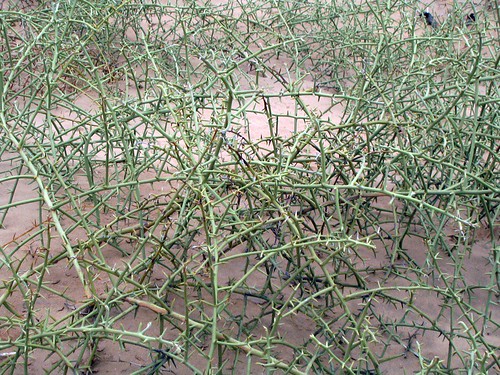
(The branches of the !nara. They are edible but very bitter tasting.) See photo above.
The !nara needs lots of water, but do not like getting wet from fog and rain. The whole delta has a fresh water aquifer underneath it and therefore there is very shallow water available. The Kuiseb delta is approximately 400 square km and is full of !nara. In winter there is more fog, and a black fungi forms on the stems and will quickly kill parts of the plant.
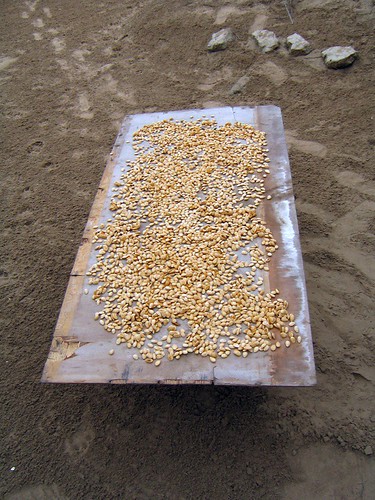
(The dried seeds of the !nara, ready to be exported.) See photo above.
The Topnaar people of the Kuiseb delta have woven their whole existence around this one fruit. When the fruit is almost ripe, they harvest it and bury it underneath the sand for three hot days. The hot sand hastens the ripening process. Then they cook the !nara’s in large pots for three hours, stirring all the time. Once cooked, the mixture is put through a sieve to separate the porridge from the seeds. The seeds are then dried in the sun and exported to Germany and Cape Town, South Africa. In Germany the nutty like seeds are used in confectionary and in Cape Town they are called butter pits and eaten like peanuts. The rest of the pot which is dried, rolled and eaten in between seasons is called Topnaar chocolate. I got to taste it and it was very similar to a fruit leather from Trader Joes. In season the Topnaar’s eat the raw !nara’s. They use the dried roots to make medicine against arthritis and diabetes, and they also smoke them.

(A sirub plant.) See photo above.
The second fruit we saw, and actually got to eat because it was ripe, was the sirub. The sirub (capparis hereroensis) fruits are eaten by the Topnaars, animals, rodents, birds, canivores and insects, while the leaves are eaten by the gazelle, oryx and ostriches. The roots are poisonous and used by the Topnaars as poison. The fruit tastes like banana, gooseberry, and elderflower.
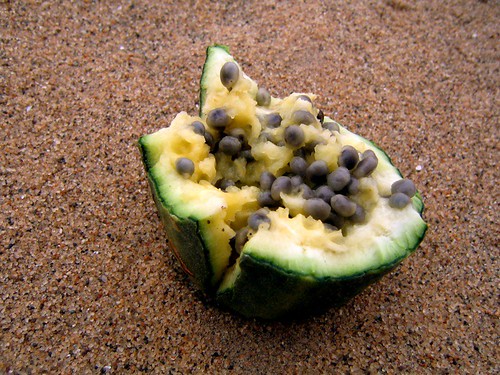
(An open sirub fruit. The yellow flesh, not the seeds, is eaten.) See photo above.
Both desert fruits are creepers and grow very quickly. They are the only plants who can survive the fast moving dunes of the delta. They grow up and over the slip faces of the moving dunes. The roots of both these plants are full of capillaries to enable them to carry the water up the high dunes. The roots are usually about 3 inches thick, but can be larger.
4 comments:
Very thorough, I like!
Nice fill someone in on and this enter helped me alot in my college assignement. Say thank you you on your information.
Sorry for my bad english. Thank you so much for your good post. Your post helped me in my college assignment, If you can provide me more details please email me.
THESE PLANTS ARE INCREDIBLE. IS THERE A WAY YOU COULD SEND ME SOME SEEDS FROM THE !NARRA AND SIRUB PLANTS. KNOWING ABOUT THESE PLANTS REALLY CAUGHT MY ATTENTION PARTLY FROM THE ANTHONY BOURDAIN TRAVEL SHOW. THE REST WAS FINDING YOUR WEBSITE AND A FEW OTHERS THAT MENTION THE VALUE OF THESE PLANTS IN THE DESERT REGIONS ESPECIALLY FOR THEIR FOOD VALUE TO PEOPLE AND ANIMALS.
Post a Comment